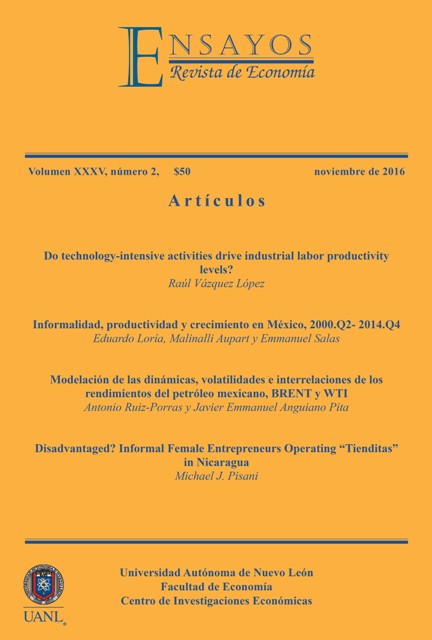Do Technology-Intensive Activities Drive Industrial Labor Productivity Levels?
Keywords:
Industry, Structural Change, Productivity, Technology Change, Economic DevelopmentAbstract
This article analyzes the contribution of technology-intensive activities to the increase in aggregate labor productivity in the industrial sector for a set of 28 countries, dividing 150 industrial classes into four groups based on their degree of technology content (High, Medium-High, Medium-Low, and Low). After decomposing the evolution of labor productivity with a statistical method, it was found that these activities did not contribute significantly to the increase in the efficiency indicator. These exercises also corroborate the absence of a global structural change in the industry that would drive levels of aggregate labor productivity.
Downloads
References
Arthur, W.B. (1989). “Competing Technologies, Increasing Returns and Lock-In by Historical Events”. Economic Journal, 99(394), 116-131.
Baumol, W.J. (1967). “Macroeconomics of unbalanced growth: the anatomy of urban crisis”. The American Economic Review, 57, 415-426.
BLS (2014). “Producer Price Index Industry Data”. U.S. Bureau of Labor Statistics. Available at:<http://data.bls.gov/pdq/SurveyOutputServlet>
Bhagwati, J. (1988). Protectionism. Cambridge, UK: MIT Press.
Chenery, H.B., and Taylor, L. (1968). “Development patterns among countries and over time”. Review of Economics and Statistics, 50, 391-416.
Chenery, H.B., Robinson, S., and Syrquin, M. (Eds.) (1986). Industrialization and growth: A comparative study. New York, NY: Oxford University Press.
Cimoli, M. (2005A). Introduction. In Cimoli, M. (Ed.), Structural Heterogeneity, Technological Asymmetries and Growth in Latin America (5-8). Santiago de Chile, Chile: CEPAL/BID.
Cimoli, M. (Ed.) (2005B). Structural Heterogeneity, Technological Asymmetries and Growth in Latin America, Santiago de Chile: CEPAL/BID.
Cimoli, M., Porcile G., Primi A., and Vergara, S. (2005). Structural Change, Productive Heterogeneity and Technology in Latin America. In Cimoli, M. (Ed.), Structural Heterogeneity, Technological Asymmetries and Growth in Latin America (9-38). Santiago de Chile, Chile: CEPAL/BID
Cimoli, M., and Porcile, G. (2009). “Sources of learning paths and technological capabilities: an introductory roadmap of development processes”. Economics of Innovation and New Technology, 18(7), 675-694.
David, P. (1985). “Clio and the economics of QWERTY”. American Economic Review, 75(2), 332-337.
Dosi, G. (1982). “Technological paradigms and technological trajectories: a suggested interpretation of the determinants and directions of technical change”. Research Policy, 11(3), 147-162.
Fagerberg, J. (2000). “Technological progress, structural change and productivity growth: a comparative study”. Structural Change and Economic Dynamics, 11, 393-411.
Fei, J., and Ranis, G. (1961). Development of the Labour Surplus Economy: Theory and Policy. Homewood, Ill: R. D. Irwing.
Furtado, C. (1963). Capital formation and economic development. In Agarwala, A., and Singh, S. (Eds.), The Economics of Underdevelopment (309-337). New York, NY: Oxford University Press.
Grossman, G., and Helpman, E. (1991). Innovation and Growth in the Global Economy. Cambridge, UK: MIT Press.
Hirschman, A. (1958). The Strategy of Economic Development. New Haven, CT: Yale University Press.
Hoffmann, W.G. (1958). The growth of industrial economies. Manchester, UK: Manchester University Press.
Holland, M., and Porcile, G. (2005). The Technology Gap and Growth in Latin America. In Cimoli, M. (Ed.), Structural Heterogeneity, Technological Asymmetries and Growth in Latin America (40-71). Santiago de Chile, Chile: CEPAL/BID
Jorgenson, D. (1961). “The development of a dual economy”. Economic Journal, 71(282), 309-334.
Lewis, A. (1955). The Theory of Economic Growth. Homewood, Ill: R. D. Irwing
Lucas, R. (1988). “On the mechanics of economic development”. Journal of Monetary Economics, 22, 3-42.
Nelson, R. R., and Pack, H. (1999). “The Asian miracle and modern growth theory”, Economic Journal, 109, 416-436.
Ocampo, J. (2005). The quest for dynamic efficiency: structural dynamics and economic growth in developing countries. In Ocampo, J. (Coord.), Beyond Reforms. Structural Dynamics and Macroeconomic Vulnerability (3-44). Washington, D.C: Stanford University Press.
Ocampo, J. (2011). “Macroeconomy for development: countercyclical policies and production sector transformation”. CEPAL Review, 104, 7-35.
OECD (2005). “Science, Technology and Industry Scoreboard 2005.” Organization for Economic Cooperation and Development. París, France: OECD.
Peneder, M. (2003). “Industrial structure and aggregate growth”. Structural change and economic dynamics, 14, 427-448.
Peres, W., and Primi, A. (2009). “Theory and Practice of Industrial Policy. Evidence from The Latin American Experience”. Comisión Económica para América Latina y el Caribe. Santiago de Chile: CEPAL.
Pieper, U. (2000). “Deindustrialization and the social and economic sustainability nexus in developing countries: cross-country evidence on productivity and employment”. Journal of Development Studies, 36(4), 66–99.
Rada, C., and Von Arnim, R. (2012). “Structural transformation in China and India: A note on macroeconomic policies”. Structural change and Economic Dynamics, 23(3), 264-275.
Roncolato, L., and Kucera, D. (2014). “Structural drivers of productivity and employment growth: a decomposition analysis for 81 countries”. Cambridge Journal of Economics, 38, 399-424.
Scherer, F. M. (1982). “Inter-industry technology flows and productivity growth”. Review of Economics and Statistics, 64, 627–634.
Silva, E.G., and Teixeira, A. A. C. (2011). “Does structure influence growth? A panel data econometric assessment of ‘relatively less developed’ countries, 1979-2003”. Industrial and corporate change, 20(2), 457-510.
Syrquin, M. (1988). Patterns of structural change, in Chenery, H.B. and Srinivasan, T.N. (Eds.), Handbook of development economics (203-273). Amsterdam: North-Holland.
Timmer, M. P., and Szirmai, A. (2000). “Productivity in Asian manufacturing: the structural bonus hypothesis examined”. Structural Change and Economic Dynamics, 11, 371-392.
UNIDO (2012). “Indstat 4 2012. ISIC Rev.3” Database [CD-ROM]. United Nations Industrial Development Organization. Vienna, Austria: UNIDO.
WB (2014). “GDP per capita.” World Bank. Available at: <http://datos.bancomundial.org/indicador/NY.GDP.PCAP.CD>.
Downloads
Published
How to Cite
Issue
Section
License
Copyright (c) 2016 Raúl Vázquez-López

This work is licensed under a Creative Commons Attribution 4.0 International License.












